First Southern Team to Fly to a Game
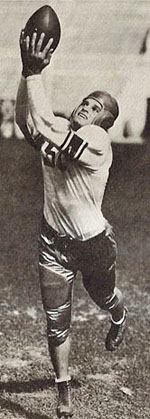
Ken Kavanaugh, Sr.
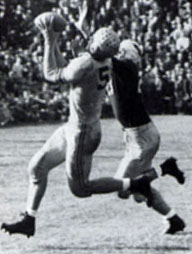
Kavanaugh catches a pass against Holy Cross.
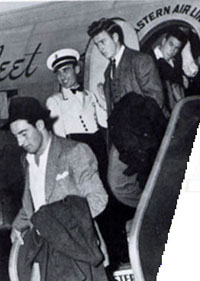
Tigers deplane
|
The 1939 Tigers lost their opener to Ole Miss in Baton Rouge. Then they hit the road for an historic trip to the Northeast.
- LSU's second opponent was Holy Cross in Worcester MA, a suburb of Boston.
- AD Skipper Heard almost bit off more than he could chew when he announced that the Tigers would travel to Boston by air.
- To protect the school from liability if the plane crashed, Heard sent "Release from responsibility forms" to parents to sign as well as team members, half of whom had reached majority. Most parents didn't understand what Heard was trying to accomplish. Those who did refused to sign the forms.
- So LSU officials tried to find someone to share the responsibility of flying the players to the Northeast even as they boarded the flight Thursday afternoon.
- Bernie Moore's coaching staff and 37 players made the trip by air, making them the first team from the South to fly to a game.
- Ken Kavanaugh, the Tigers' star end, admitted he was on edge during the 11-hour, four-stop journey on two Eastern Airlines DC-3s. I was trying to figure out how they kept that big machine in the air. I wasn't sick. I was just nervous.
- Kavanaugh wasn't the only Tiger flying for the first time. Their uneasiness wasn't made any better by Dave Bartram, an engineering major. When Moore asked Dave what he was working out with his slide rule, the senior guard replied: Coach, I've just figured out that, if the engines quit, it will take us 32 seconds to hit the ground.
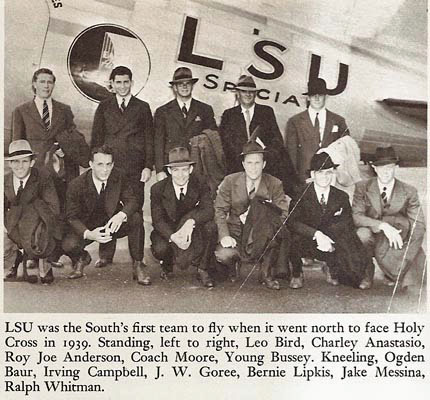 The Crusaders were an eastern power in those days.
- They had compiled a 40-5-4 record over the previous five seasons.
- HC had beaten Georgia two years in a row.
- LSU had actually dropped Texas, a team they'd beaten three straight, to schedule a home-and-home series with Holy Cross to beef up the schedule.
Coach Joe Sheeketski's squad had impressed the reporter for the Portsmouth (NH) Herald as "a powerful contender for national honors" after their 28-0 victory over a "tough" Manhattan team.
- With only two starters missing from the '38 team that lost but one game, the Crusaders used "the Notre Dame 'platoon' system," not surprising as Sheeketski played for Knute Rockne from 1930-32.
- Still, the Herald writer cautioned: Come Saturday, Holy Cross meets an even sterner test in the light but speedy Louisiana State eleven ...
- Joe didn't seem to see the upcoming contest that way. He was so well satisfied with his team's performance in the Manhattan game that he decided not to scrimmage his regulars during the week.
- Kavanaugh recalls: They laughed at us. They were asking us what we made the trip for.
|
The Associated Press summary of college football results for October 8 included this paragraph.
Flatly refusing to believe all the tall tales they heard of Holy Cross power, the Tigers of Louisiana State shelled the Crusaders 26-7 at Worcester as Ken Kavanaugh, great end, caught three passes for touchdowns and scored the other on a 90-yard run after intercepting a Holy Cross aerial.
- All three touchdown passes came from sophomore LHB Leo Bird, and the "aerial" that Ken intercepted was actually a lateral.
- The Tigers held the "reputedly powerful Crusaders" scoreless until the fourth quarter before an "amazed crowd" of 24,000 at Fitton Field. HC's score came only after recovering a fumble on the LSU 10.

Leo Bird carries against Holy Cross. The Tigers seized the upperhand early.
- Sophomore TB Leo Bird boomed a 66y quick-kick out of bounds inside the one.
- The ensuing punt from the end zone traveled only to the 32. After one first down, LSU faced third-and-11 at the 22. Marty Mule: Kavanaugh faked to the outside and shot downfield before cutting back to the inside to look back in time to Bird's high pass coming toward him. At that very instant, the transmission of the radio broadcast was severed. ... Twenty minutes later, when the broadcast resumed, listeners found out what the dismayed crowd witnessed: Kavanaugh, with a high leap, took the ball right out of the hands of a safety and spun into the end zone for the first touchdown.
- The 6'3" 200 lb end made another spectacular catch in the second quarter. Mule: Leading Kavanaugh, Bird fired a shot toward the corner of the end zone, and again a defender had a chance at the ball. As the defensive back reached high for the ball, Kavanaugh stretched his frame as far as it would stretch, made the catch, and stepped across the goal line.
- Ken caught another touchdown pass in the third period, this one from the 15.
- But his most remembered play of the day came on defense later in the period. HC finally mounted a drive that penetrated the LSU 15. Mule: The Tiger defense ... strung out a wide option play, and the ball-carrier, about to go down, tried to lateral to another back. The ball seemed to hang weightless for an instant, then Kavanaugh picked it off and brought it back 74y for LSU's last touchdown.
This was Ken's second defensive touchdown. In 1937, Rice had the ball inside the Tiger one. The ball-carrier was hit hard, knocking the ball out of his hands. Kavanaugh grabbed it straddling the goal line and raced the length of the field. LSU won 13-0.
The chartered planes landed at Floyd Bennet Field in Brooklyn after the game so that the LSU contingent could celebrate their victory at the New York World's Fair. Then they continued on their way.
- "A roaring, frenzied crowd of 5000 LSU students accorded their Bengal Tigers a glorious welcome" Sunday night after the team completed the 3,000-mile air journey.
- The students packed the gym-armony and stood and roared out a tribute to the team as the players were brought in on the shoulders of their classmates.
- Thousands of voices yelled "We want a holiday" and "Let's go to Nashville" (for the Vanderbilt game) for almost an hour before the gridders appeared.
- The rafters rang when Kavanaugh was carried to the stage. At the mike, he said, "The boy you want up here is Leo Bird," and beckoned the blond sophomore to come forward.
- When Bird took the mike, he told the crowd, Kavanaugh has been catching passes before I came here and he'll keep on catching them. He's the best pass receiver in the world, and he's the best boy that ever hit this campus.
Meanwhile, back in New England, Sheeketski drove his team through its longest and hardest scrimmage of the year the following Tuesday to prepare for Georgia's visit. He had apparently learned a lesson about underestimating a Southern opponent. (It worked. The Crusaders defeated the Bulldogs for the third straight year, 13-0.)
Ken's performance in the most populous section of the nation helped him become LSU's second All-American end in three years after Gaynell Tinsley.
- Ken tied with Bobby Foxx of Tennessee as Most Valuable Player in the SEC.
- Kavanaugh won the Knute Rockne Memorial trophy as the nation's outstanding lineman.
- He finished second to Iowa's Nile Kinnick in the Heisman Trophy balloting.
- Coach Moore praised his star: Kavanaugh was a pass completer rather than receiver, simply because he'd catch passes no one else could get to.
- Kavanaugh agreed on the importance of the Holy Cross game. It was everything. It was played in the East, where the most influential sportswriters could see us. They really didn't know the quality of players and teams elsewhere in the country. We had a good game, and they were impressed.
Despite Kavanaugh's great play, the Tigers did not enjoy a successful 1939 season. The final mark was 4-5, with all five losses in the SEC.
References: The Fighting Tigers II: LSU Football, 1893-1980, Peter Finney
Game of My Life: LSU, Marty Mule (2006)
Top of Page
Memorable Game: 1991 LSU- FSU
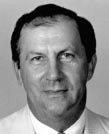
Curly Hallmann
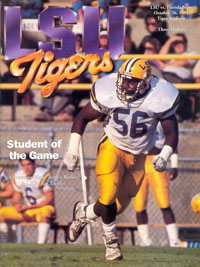
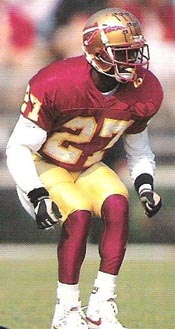
Terrell Buckley
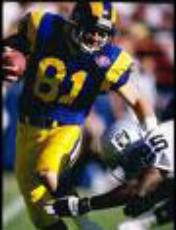
Todd Kinchen
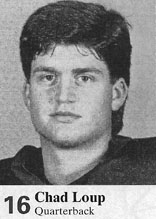
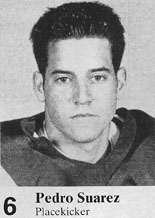

Casey Weldon

Edgar Bennett

Amp Lee
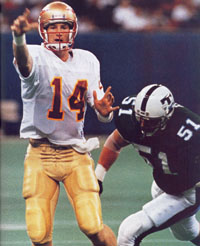
Brad Johnson
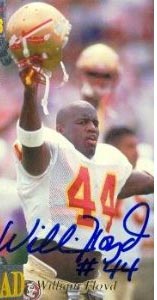
|
The Tigers and Seminoles first played in the inaugural Peach Bowl in 1968.
- LSU won 31-27 in a game pitting former Paul Dietzel assistants Charlie McClendon and Bill Peterson.
- The two schools next met in 1979 when Bobby Bowden brought his #8 Noles to Baton Rouge and won 24-19.
- The teams played in Tiger Stadium the next four seasons, with FSU winning three: 16-0 in '80, 38-14 in '81, and 40-35 in '83.
- The only Tiger win in that span came in 1982, 55-21 in the second-to-last regular season game to propel LSU to the Orange Bowl.
The teams didn't meet again until 1989.
- Florida State prevailed in Tiger Stadium 31-21 on ESPN.
- LSU finally visited Tallahassee the next season, getting creamed 42-3 on TBS in Mike Archer's last season as head coach. The game ended with a free-for-all.
That brings us to 1991, and the only game in the series that yours truly attended.
- Curly Hallman's first Tiger team stood at 3-3 entering the October 26 clash. Hallman's Southern Miss squad, led by an unknown quarterback named Brett Favre, had upset FSU in the opening game of the '89 season.
- Bowden had warned his team after the previous week's lackluster victory over Middle Tennessee State. You weren't ready to play. Men, if we don't play any better than that, we will lose next week, I can promise you. LSU is not having a good year. But when they play against No. 1, they'll be like everybody else and be comin' after us.
- He also didn't want the fight that ended the '90 game to be a distraction. He told the players: I seldom ever tell you what to tell the press. But if any of them ask you about that fight ... well, I know what I'm gonna say when they ask me. I'm gonna say, 'No comment.' Don't let them start talking about that fight last year. They'll want to keep bringin' it up and bringin' it up.
71,019 welcomed the 7-0 Seminoles, who were ranked #1.
- Persistent rain for days made the Tiger Stadium turf soggy and caused cancellation of the usual pregame parade of Mike the Tiger in his cage around the field.
- In his pregame talk in the locker room, Bowden predicted what would happen. LSU is going to be fired up, full of emotion. They're going to come at you and attack you. But that's only going to last so long. We've simply got to knock it out of 'em. Backs, protect the ball. It's a little wet out there. Defense, knock the ball out of there. Stop the run first, make 'em throw.
The fired-up Tigers, 27-point underdogs, shocked the ESPN audience by jumping to a 13-0 first quarter lead.
- On the Tigers' second play from scrimmage, CB Terrell Buckley bit on a run fake, allowing All-SEC WR Todd Kinchen to sprint past him to haul in a 63y touchdown pass from QB Chad Loup. The stadium exploded, making it impossible to hear anything except the roar of the crowd.
- After Tiger McMillon returned the kickoff to the 47, QB Casey Weldon, playing despite pains in his hip, calf, and shoulder, ran the play the offensive staff had decided to lead off with - a run fake and a rollout pass to the tight end.
- Sure enough, Weldon hit Lonnie Johnson, who took off downfield only to fumble when hit, LSU recovering.
- Loup hit FB Leo Abel for a gain of 30 to the 25. After three plays gained seven, Pedro Suarez connected on a 35y field goal. Just like that, LSU led 10-0 less than three minutes into the game.
- Another rainstorm midway through the first period made it hard to see the other side of the field.
- The din increased as the Tiger defense stuffed the Noles and forced a punt, which Kinchen returned to the FSU 42. Taking a page from Bowden's playbook, LSU picked up six on a reverse, then gained a first down on a one-handed catch by TB Sammy Seamster. Another TB, Odell Beckham, ran to the 15 to move the chains again. But the Seminole defense stiffened, and LSU settled for another field goal, this one 32y. 13-0 LSU
- FSU offense coordinator Brad Scott decided to resort to smash mouth football. Amp Lee and Edgar Bennett pounded out two first downs on four rushes. The march reached the LSU 24, but Weldon misfired on a third-and-four fullback delay pass. Eschewing the field goal, Bowden called another play-action pass, but OLB Shawn King forced Weldon out of the pocket and tackled him short of the first down.
- Mickey Andrews' defense finally stopped the Tigers. Buckley returned the punt 23y to the Seminoles' 40.
The visitors finally dented the scoreboard in the second period.
- Weldon got 33y on two
passes and ran once for four more to put the ball at the
one. Lee went over from there on
third down. Gerry Thomas added the PAT to make it 13-7.
- FSU got a big break when they recovered a botched a punt attempt in the rain at the eight. But the offense went nowhere, failing again on fourth down.
- An interception provided the Seminoles with another chance, but Weldon, forcing the ball into coverage, returned the favor three plays later.
- LSU drove to the 19 but bogged down - literally - and had to settle for another Suarez field goal, a 41-yarder, to lead 16-7 at the break.
- The Tigers had twice as many first downs as Florida State and half as many turnovers.
- Bowden was calm as he addressed his team at halftime. Men, you've got the most important half of your life coming up. If we execute, we can get this thing right back in perspective.
After the Marching Chiefs and the Golden Band from Tigerland gave their usual outstanding halftime performances despite the wet conditions, the rain began again.
- FSU went 78y for its second score
with Lee getting 16 on four carries and Edgar
Bennett gaining 23 more on five carries. Weldon passed
twice for 38, including a 22y touchdown aerial to Lee to make it 16-14. During the drive, Robbie Baker had to leave the game after being gashed by a cleat. He would not be the last O-linemen to drop out of action.
- LSU also moved the ball on its first possession. A 15y run and a 15y Loup-to-Kinchen pass put the pigskin at midfield. But Loup pressed his luck with a long throw that Leon Fowler intercepted at the 21. The Tiger fans, so accustomed the last few years to blowing leads, lost some enthusiasm. The FSU coaches on the sidelines could finally hear themselves talk.
- Weldon had hurt his knee on the previous drive and had to leave after one play of the next possession. He would soon be joined on the sidelines by OT Kevin Mancini. Brad Johnson took over under center and connected with Bennett for 23y. But a personal foul call against the other tackle, Robert Stevenson, resulted in his ejection. So three of the five starters on the offensive line were gone.
- On third and 11, Bowden called for the gadget play he'd been saving for weeks - Smoke Y Hide. The tight end would throw himself at the feet of a defender at the line of scrimmage. Then he would crawl into the open in the opposite direction of the play. The play worked as Lonnie Johnson grabbed the pass QB Johnson threw back across the field, but Lonnie's momentum took him out of bounds 3y short of the chain. So FSU punted.
- When LSU booted back to its 47 four plays later, Weldon convinced the trainers he could play. With the second-string linemen blocking like fiends, backup TB Sean Jackson from New Orleans (who pleaded with his mates at halftime that they could not lose this game in front of his family and friends) and backup FB William Floyd pounded the ball into LSU territory. Facing third down on the 16, Weldon dumped the ball to Floyd just beyond the line of scrimmage. The fullback escaped one would-be tackler and set sail downfield. At the five, he ran over CB Derriel McCorvey before three purple-shirted tacklers corralled him at the one. Derriel was the brother of Nole CB Erroll McCorvey. (Video of pass to Floyd to the one) Floyd was stuffed for no gain as the third quarter ended.
- Weldon's sneak gained nothing before Floyd finally pushed into the end zone to give the Seminoles their first lead of the evening, 21-16. The touchdown capped a 47y drive.
- On LSU's next possession, DE Toddrick Mclntosh
stripped the ball from Loup,
and LB Kirk Carruthers recovered at the 20. With the rain and injuries, FSU narrowed its offense to two plays - toss sweep to Lee and the fullback plunge. FB Paul Moore alternated with Amp to move to the one from where Lee ran around the left side to the end zone with 10:14 left.
The Noles lined up to kick the PAT, but Johnson fumbled the wet ball and jumped up to throw a pass. But S Ivory Hilliard intercepted at the goal line and set sail for two points the opposite way. However, Floyd didn't give up and chased Ivory down at the 10 - another gutsy play by a backup. William collapsed when he reached the bench.
- The rain increased, but, down by 11, the Tigers had to pass. Loup put together a four-minute drive that reached the five before DE Dan Footman batted down Chad's fourth down pass. That was the Tigers' last gasp.
Bowden praised his men in the locker room. That was one of the greatest wins Florida State ever had. We had everything in the world work against us, everything in the world. But you guys just played brilliantly. I'm proud of every one of you.
The bruising battle in the slop inflicted permanent damage on Florida State.
- The hard-hitting Tigers knocked 17 Seminoles out of the contest. Six starters, including Weldon, missed the next game at Louisville. Two offensive linemen were lost for the season.
- FSU beat the Cardinals 40-15 and South Carolina at home, 38-10 to clear the decks for the double-barreled finale against Miami and Florida.
- The #2 Hurricanes won in Tallahassee 17-16 when Thomas missed a field goal wide right in the last seconds. Then the Gators prevailed in Gainesville 14-9.
- Bowden's Boys defeated Texas A&M in the frigid Cotton Bowl 10-2 to finish #4 in the final AP poll.
- In the meantime, 5-6 LSU missed the bowl party for the third straight year.
Reference: Saint Bobby and the Barbarians: The Inside Story of a Tumultuous Season
with the Florida State Seminoles, Ben Brown (1992)
Top of Page |
Did You Know? 7-0 in 1973
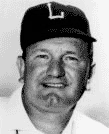
Charlie McClendon
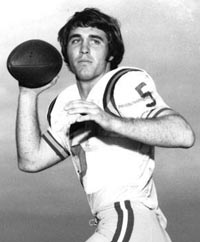
Mike Miley
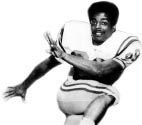
Mike Williams
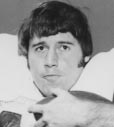
Brad Davis
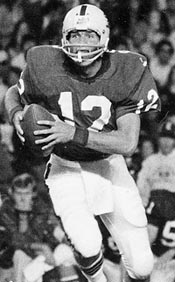
Jeff Grantz
|
When the 2010 Tigers began 7-0, it was the first time that had happened since 1973.
- Conventional wisdom opined that Charlie McClendon's '73 team would have to rely on the defense until the young offense matured.
- The Bert Jones era had just ended, leaving the quarterback position in the hands of sophomore Mike Miley from Metairie. The season would also mark the debut of highly anticipated RB Terry Robiskie.
LSU would not open with a pushover.
- Colorado, #10 in the preseason poll, came to Baton Rouge a 2-point favorite. The Buffaloes had won in Tiger Stadium two years earlier, 31-21. The Tiger defense lived up to its billing, holding the visitors scoreless until the third quarter in the 17-6 upset. Miley connected with Ben Jones, Bert's brother, for a 30y touchdown.
- The following week, LSU survived three lost fumbles and two interceptions to prevail 28-23 over Texas A&M. Sophomore CB Mike Williams saved the game in the final moments with a spectacular pass deflection.
- Two more home games produced victories over Rice, 24-9, and Florida, 24-3.
Three of the next four games would be on the road.
- To win on the road you need to play good D. The Tigers did that, holding Auburn to 90y on the ground in the 20-6 triumph. Junior TB Brad Davis ran for 58y, set up a touchdown with a 24y reception, and scored on a 28-yarder from Miley.
- The following week, back home, the Tigers suffered a letdown against three-touchdown underdog Kentucky, falling behind 14-0. But Miley led a rally that produced a 28-21 victory and a 7-0 record for the second straight year.
The '72 Tigers had lost their eighth game. But that was not the case in '73.
- The next opponent was Paul Dietzel's South Carolina Gamecocks in Columbia. The home team had a veer quarterback named Jeff Grantz who resembled Miley not only in how he played football but also in the fact that his first love was baseball. The two went back and forth as the teams traded the lead until LSU finally prevailed 33-29. Miley hit Jones on a 47y pass for the winning touchdown with a minute left. Still, Grantz led his club to the 12 as the final horn sounded.
- That moved the Tigers to #7 and set up a national TV game against Ole Miss in Jackson. The Rebels were 4-4, with veteran coach Johnny Vaught taking back the reins from Billy Kinard three games into the season. LSU had not beaten Ole Miss in an afternoon game in Jackson since 1934. Rebel fans were amped for the game to avenge the Jones-to-Davis miracle pass the year before when the clock mysteriously showed one second left after an incompletion. Never has the home crowd been more disappointed. Davis broke loose for a long gain early in the game to start a 51-14 rout. McClendon had won his first eight games for the first time in his career.
- Mississippi State fell 26-7 on homecoming: 9-0.
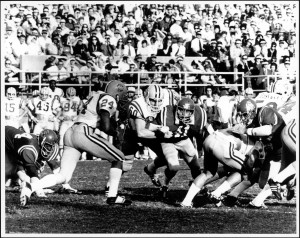
LSU- Ole Miss 1973 That set the stage for a Thanksgiving Night showdown with undefeated Alabama, ranked #2.
- The national audience (and yours truly in the South upper deck) saw the Tiger defense do a fine job of stopping Bear Bryant's wishbone that had been averaging over 500y per game. LSU ran 77 plays to the Tide's 53 and made 21 first downs to 11.
- But Alabama recovered a fumble on the Tiger 19 that led to an immediate touchdown. Also Bama scored on a 49y pass and a 77y pass when Williams tripped.
- A 40y run by Davis made the final score 21-7.
The season that began so promisingly ended in bitter disappointment.
- A record Southern crowd of 86,598 (including yours truly) packed Tulane Stadium to see the Green Wave triumph 14-0 to break a winless streak in the annual rivalry that extended back to 1948.
- LSU finished the year with a third straight loss, to Penn State 16-9 in the Orange Bowl.
|
Profile: John Ed Bradley
This article is inspired by meeting author John Ed Bradley and hearing him speak to a group of high school students.
- John Ed from Opelousas LA lettered at C for LSU from 1976-79.
- The son of a football coach (but not his coach at Opelousas High), Bradley made All-Parish, All-District, All-State, and played in 1976 LA High School All Star Game. Considered the finest C in the state, his name dotted numerous LA Top 10 Blue Chip lists.
- Although LSU assistant Jerry Stovall had recruited him, Bradley waited until late in the commitment period to receive an official offer from LSU. Finally, Coach Charles McClendon called the school and got John Ed out of class to tell him that he'd love to have him in Baton Rouge.
Bradley contributed immediately for the Tigers.
- As a freshman, he made the SEC All-Rookie Team and became the first offense lineman in the modern era of LSU football to win a varsity letter his freshman year as the Tigers went 6-4-1.
- The '77 squad finished 8-4, losing to Stanford in the Sun Bowl.
- In 1978, LSU went 8-3 in the regular season but lost to Missouri 20-15 in the Liberty Bowl.
John Ed was elected a captain for his senior year, which had been designated McClendon's last by AD Paul Dietzel.
- At 6'4" 245 (light for a center today but typical of that era), Bradley graded 93% for the USC game in Tiger Stadium, which the Trojans pulled out in the last minute thanks to a controversial penalty.
- Finishing with a loss to Tulane in the Superdome, 24-13, LSU ended Charlie Mac's tenure with a trip to the Tangerine Bowl.
- In his book It Never Rains in Tiger Stadium, Bradley wrote this.
For me, it ended on December 22, 1979, at the Tangerine Bowl in Orlando. We beat Wake Forest that night, 34-10, in a game that came and went in a chaotic, brightly colored blur, as all games do. When it was over Big Ed Stanton and I grabbed our heroic old coach, hoisted him up on our shoulders, and carried him out to midfield. Newspapers would run photos of Coach Mac's last victory ride, with Big Ed and me, smeared with mud, serving as his chariot.
Bradley majored in English in order to become a writer.
- Stovall, who took over the LSU program after McClendon's replacement, Bo Rein, died in a plane crash, offered Bradley a graduate position on the coaching staff, but John Ed declined. "I want to be a novelist," he told Jerry, who admitted that was the first time any player had told him that.
- After briefly attending law school, John Ed worked for The Washington Post. Although he wanted to put his football career behind him, his editor assigned him to do a story on Bear Bryant.
- Later, the editor sent Bradley to cover the 1982 LSU-Alabama game in Birmingham. However, he summarized his intention in It Never Rains: "I wasn't going anywhere near a football stadium where LSU was playing for as long as I lived. ... I wasn't the kind of writer who wrote game stories, especially ones about LSU."
- He made it to the stadium but "unable to watch more than the first few minutes, I retired to the men's room and locked myself in a stall." He did go to the LSU locker room afterward where some of the players recognized him. He phoned his editor later and told him he wasn't able to write the piece.
- The only news story he wrote for the Post about LSU concerned Billy Cannon after the Heisman Trophy winner pled guilty in 1983 to federal counterfeiting charges.
|

John Ed Bradley
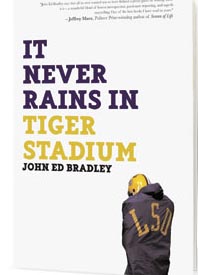
 The picture Bradley referred to, with the
players carrying Coach McClendon cropped out. |
Bradley fulfilled his dream of becoming a novelist.
- He started in 1988 with Tupelo Nights, whose lead character is a former All-American football player at LSU.
- Next came The Best There Ever Was in 1992.
- Love and Obits followed in 1993, then Smoke in 1995.
Bradley's visit to Coach Mac on his deathbed became a turning point in the novelist's life after avoiding his old coach, whom John regarded as a second father, until that time.
- Bradley wrote about the experience in an award-winning article in Sports Illustrated in 2002. John Ed recalled the reaction to the piece in a 2007 New York Times interview.
After that magazine piece, I heard from Sports Illustrated's letters department and they told me that they received more letters for that piece than any, I think, that year. That little piece took me four days to write, just four days. I just didn’t anticipate that response.
Coach Saban contacted me when the magazine piece came out. His wife wrote me some letters, and he wrote me two letters about the story, and he had me come and speak to the team. And they went on to win the national championship that season. That was quite a gift to me, to be invited to speak to them. It struck a chord with him.
- The SI article led to the autobiographical memoir It Never Rains in Tiger Stadium published by ESPN Books in 2007. The book culminated a process whereby the author came to grips with his past and helped him deal with his fear that he would always be defined as a former LSU football player who never did anything more significant in his life.
- Bradley wrote another SI piece in 2007, "The Best Years of His Life," on playing football in the SEC.
"Bleeding Purple and Gold," Business Report.com article on Bradley | Top of Page
|


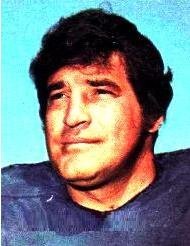
Remi Prudhomme
|
At least one former LSU Tiger played in each of the first six Super Bowls.
- Super Bowl I (1966-7): Green Bay 35 Kansas City 10
Chiefs
42 Johnny Robinson (6-1, 205) FS – 6 tackles, 3 assists
Packers
31 Jim Taylor (6-0, 215) FB – Rushing: 17/56y/touchdown; Receiving: 1/-1y
- Super Bowl II (1967-8): Green Bay 33 Oakland 14
Raiders
33 Billy Cannon (6-1, 215) TE – Receiving: 2/25y
- Super Bowl III (1968-9): New York Jets 16 Baltimore 7
Colts
76 Fred Miller (6-3, 250) DT – 3 tackles, 5 assists
53 Dennis Gaubatz (6-2, 232) MLB – 10 tackles, one assist, one sack
- Super Bowl IV (1969-70): Kansas City 23 Minnesota 7
Chiefs
42 Johnny Robinson (6-1, 205) FS – 2 tackles, one interception/9y
Sub: 65 Remi Prudhomme C – one tackle
Vikings
60 Roy Winston (5-11, 226) LLB – 4 tackles, 6 assists, one sack
- Super Bowl V (1970-1): Baltimore 16 Dallas 13
Colts
76 Fred Miller (6-3, 250) DT – 5 tackles, one assist
- Super Bowl VI (1971-2): Dallas 24 Miami 3
Cowboys
Sub: 87 Bill Truax TE – Receiving 0/0
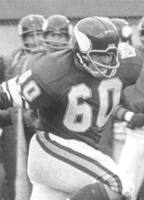
Roy "Moonie" Winston |
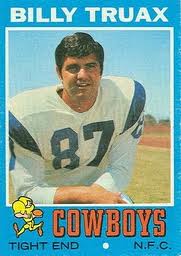 |
Reference: The Ultimate Super Bowl Book, Bob McGinn
|

Jimmy Taylor
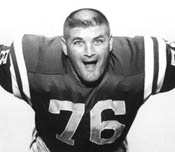
Fred Miller
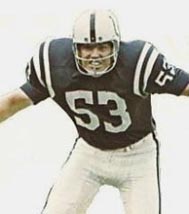
Dennis Gaubatz
Top of Page |
|

Roy "Moonie" Winston

Earl Leggett
|
Here are some more LSU alumni who played or coached in Super Bowls.
- Super Bowl VIII (1973-4): Miami 24 Minnesota 7
Vikings
60 Roy Winston (5-11, 222) LLB – 4 tackles, 3 assists
- Super Bowl IX (1974-5): Pittsburgh 16 Minnesota 6
Vikings
60 Roy Winston (5-11, 222) LLB – 6 tackles, 6 assists
- Super Bowl X (1975-6): Pittsburgh 21 Dallas 17
Cowboys
Sub: 59 Warren Capone LB – one tackle
- Super Bowl XI (1976-7): Oakland 32 Minnesota 14
Vikings
Sub: 60 Roy Winston LB – one tackle
- Super Bowl XV (1980-1): Oakland 27 Philadelphia 10
Raiders
D-line coach: Earl Leggett
- Super Bowl XVI (1981-2): San Francisco 26 Cincinnati 21
Bengals
40 Charles Alexander (6-1, 221) RB – Rushing 5/17, Receiving 2/3
Reference: The Ultimate Super Bowl Book, Bob McGinn
Top of Page
|
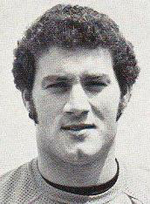
Warren Capone
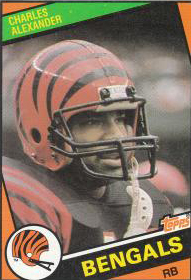
|
|
Tyler Lafauci lettered at offensive guard/defensive tackle for LSU in 1971-72-73. He made All-SEC in '72 and '73 and All-America in '73.
- Tyler grew up in Kenner LA and went to De La Salle High School in New Orleans.
- Lafauci made all-state on both offense and defense. He also earned a spot on some high school All-American squads.
- "I was so close to going to Alabama. I actually wanted to go to Alabama, but my parents wanted me to go to LSU ... the night before signing day, Tulane, Alabama, and LSU came to our house ... I knew I wasn't going to go to Tulane, but I felt that, living in New Orleans, I needed to listen. Then the Alabama guy came, and I was really excited about that. And then LSU came in. It was Coach McClendon, Barry Wilson (who was actually recruiting me), and Donald Ray Kennard, the academic advisor."
- "They sat down, and instead of getting a half hour, they got two and a half hours. I felt like I was in a Vietnamese prison camp. Everybody wanted me to go to LSU but me. He would say, 'Son, we really want you to sign tomorrow.' And I had a trip planned. I had never been out of town and had never been anywhere. I had a recruiting trip planned to Baylor."
- "It was unbelievable. Finally, two and a half hours later, my momma says, 'Tyler, why don't you just sign tomorrow with LSU?' Okay, I'll sign."
- "It wasn't five minutes after they left that Coach Bryant called. I had visited Alabama, and they had offered me a scholarship in his office. I felt I had to come home and talk to my parents. But he called me five minutes after LSU left and told me he knew who had been there, but he really wanted me to sign with them, that I would be playing for them ..."
- "I was just sick about it, but I told him I just committed to LSU. He said, 'Son, look, you're gonna be successful anywhere you go. I'm going to wish you the best of luck.' And then he said, 'I'll see you on Saturday night.'"
Alan Faneca lettered at guard in 1995-96-97 before skipping his senior year for the NFL, where he has compiled a Hall of Fame career. He made All-SEC in '96 and '97 and All-America in '97.
- "I grew up watching the Tommy Hodson era and the successful teams they had. I grew up on the west bank in Harvey before we moved to Texas prior to high school, so I knew the LSU tradition and followed them a lot."
- "I committed to Alabama the night before signing day. I graduated in 1994, and this was not long after they won the national championship [1992]. I visited there, and people were showing off their national championship rings. I got mesmerized by that. I committed."
- "It had come down to Alabama and LSU, and the LSU coach who was recruiting me was not happy. He cussed me out a little bit, and it stirred me up. ... I said to myself, What the hell am I doing? I have 30 things on my wall; I have a Shaq poster, an LSU shirt. So I changed my mind the morning of signing."
- "I was at my house in Texas. I called my O-line coach at LSU, Larry Zierlein, and told him I'd changed my mind. Curley Hallman called five minutes later to make one last push, but he didn't know the whole story yet. He said, 'Hang on, I will call you back.' He called back and said, 'Congratulations.'"
- "It wasn't over yet, because Alabama wasn't too happy. I know it wasn't the best timing. Gene Stallings kept calling and calling; he was pretty hacked off. Eventually, we had to take the phone off the hook."
Reference: What It Means to Be a Tiger, Ray Glier
Top of Page |
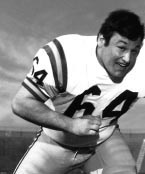
Tyler Lafauci
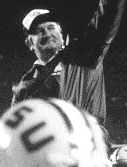
Coach Charles McClendon

Alan Faneca

Coach Curly Hallman
|
|
Memorable Game - Tulane 1937
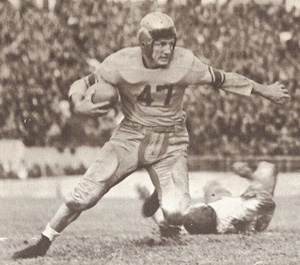
"Pinky" Rohm
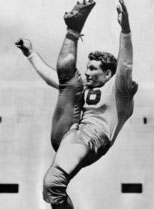
Young Bussey
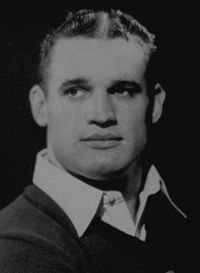
Ken Kavanaugh
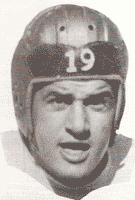
Jimmy Cajoleas
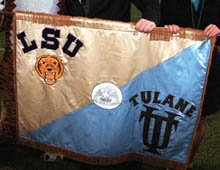
"The Rag"
|
Times-Picayune Sunday, November 28, 1937
Hall Loses Pants to "Pinky" Rohm as Bengals Win
Charles "Pinky" Rohm, acting captain of the Louisiana State university football team, had a highly-prized souvenir tonight of the 20-to-7 victory over Tulane.
It was the seat of Norman Hall's football pants.
Hall was cocaptain of Tulane with Norman Buckner. He and Rohm each bet the other the seat of his pants in the game, an annual struggle which closed the season for both teams.
Rohm, outstanding on offense for L.S.U., invaded the Tulane dressing room after the contest, armed with a pair of shears. Two minutes later he ermerged with the prize. "I might frame it," he said.
38,519 packed Tulane Stadium to watch Bernie Moore's 8-1 Tigers face Red Dawson's 5-3-1 Green Wave.
- Tulane knocked the visitors on their heels in the first quarter when "Honest John" Andrews leaped high to snag one of Rohm's aerials and return the interception 59y to paydirt. The PAT put the underdogs on top 7-0.
- His ground game at a standstill, Moore inserted his shock troops for the second quarter, and they turned the tide with their passing. With Young Bussey of Houston TX slinging and Ken Kavanaugh (Fort Washington PA) and "Jabbo" Stell (Shreveport) catching, LSU moved to its first touchdown, a 9y fling to Kavanaugh. The extra point boot by Jimmy Cajoleas (Warren Easton High School, New Orleans), flew wide. The teams left the field at halftime with Tulane clinging to a 7-6 lead.
- The Tigers' superior depth began to take its toll on Tulane in the second half. Bussey's accurate punts kept the Greenies bottled up until LSU cranked up a go-ahead drive. Bussey connected with Kavanaugh for 31y to the nine. Facing fourth down on the four, LSU lined up for a field goal. Cajoleas fumbled the snap, then started to run before throwing over the middle into a crowd of players. E Larry King (New Orleans) ended up with the ball and fell over the goal to put the Tigers ahead. Some observers thought LSU had an ineligible man downfield, but no official threw a flag.
- Rohm (Fortier High School, New Orleans) set up the clinching touchdown by returning a punt 18y to the Tulane 26. Arthur Morton (Tallulah) picked up 17 on two smashes, and Rohm sliced off tackle to score standing up. Guy Milner (Alexandria) again kicked the extra point.
- The victory clinched a spot for the Tigers in the Sugar Bowl for the second straight year. They again lost, this time to Santa Clara 6-0.
An AP postscript on the Tulane game.
NEW ORLEANS, Nov. 27 — Wild fighting broke out on the gridiron of Tulane stadium here today at the end of the game between Tulane and Louisiana State university.
Fists flew as a handful of policemen ineffectively sought to break up the scrapplng.
Louisiana State students won the displeasure of Tulane students by tearing down Tulane's goal posts as players left the field. The L.S.U. students, identified by the gray uniforms of L.S.U. military cadets, attemped to march across the field in exultation of their 20-7 victory over the rival Tulanians.
Groups of excited fans gathered on the field, those not fighting watching the melee.
Gradually the groups moulded into one wild mass which moved across the field to the L. S. U. goal posts guarded by police.
The officers walked away and the crowd stalled, breaking up into small knots of arguing fans.
Two years later, shortly before the Tigers returned to Tulane Stadium, the student councils of the two schools declared a "neutrality zone" for the clash to avoid a repetition of the turmoil that followed the '37 game.
- "The football field shall remain neutral regardless of the outcome of the game," read the key statement of the joint declaration.
- Further, the two schools decided that a "TulaneLSU flag, bearing the state seal, would be awarded to the winning school by the loser after each annual game as a symbol of good sportsmanship between these two great Louisiana institutions of learning."
- The "flag" became known as "The Rag" and is still presented after each TulaneLSU game.
|
|
The 1927 Tigers of Mike Donahue reeled off four shutouts to start the season. Combined with the last three contests of 1926, that made seven straight games without allowing a single point.
- The streak began with a 14-0 victory over Arkansas at the Louisiana State Fair Stadium in Shreveport on November 6, 1926 before 8,000 fans. Charlie Mason returned a punt 70y for one touchdown and tossed a touchdown pass to Everette Haynes for the other.
- The Tigers returned to Baton Rouge the following week to upend Ole Miss 3-0. The lone tally came on Guy Nesom's 20y field goal in Q2 as 19,000 cheered.
- That set the stage for the annual finale against Tulane in the Green Wave's new stadium in New Orleans. Coach Clark Shaughnessy, adopting a tactic employed by Knute Rockne at Notre Dame, started his second string to the surprise of the crowd of 22,000. LSU turned the ploy to its advantage, as Allen Connell broke off a 34y run to set up a touchdown by Haynes - LSU's first against Tulane in four years. The game stayed 7-0 although the home team drove to the Tiger one in Q3, only to be stopped on 4th down by Jess Tinsley, all-Southern E. The victory gave LSU a 6-3 record for the season.
The next season began with two romps in Tiger Stadium.
- Louisiana Tech fell 45-0.
- Southwestern Louisiana followed suit, 52-0.
That set the stage for the clash with Alabama, which had belted the Tigers 42-0 and 24-0 the previous two seasons.
- The game played in "a sea of mud" in Birmingham provided a moral victory of sorts for LSU as Bama failed to score for the first time in 31 starts.
- It was also the first time in three years that a Southern opponent had so much as tied Wallace Wade's powerhouse, fresh off two straight Rose Bowl appearances.
- A drizzle began as the teams lined up for the kickoff, and the rain got stronger as the afternoon progressed.
- 12,000 saw the heavier Tide keep the Bengals on the defensive throughout most of the game. Bama gained 11 first downs to only one for LSU.
- Alabama made the deepest penetration, being stopped inches short of a first down inside the Tiger 10. The Tide lost star FB Archie Taylor in Q2 when he was knocked unconscious and carried off the field.
- Afterwards, excited LSU officials gave Donahue, whose contract had one more year to go, a six-year extension at $10,000 per season.
LSU returned to Alabama the following week to continue its amazing streak.
- The Tigers upended Auburn, the school Donahue coached before coming to Baton Rouge, 9-0 in Montgomery after defeating the same opponent 10-0 at the same venue the year before.
- Nesom's 30y field goal provided an early lead. A 60y touchdown pass from Lola "Babe" Godfrey to Haynes nailed down the victory.
The Tigers defeated Mississippi State the next week in Jackson 9-7, the scoreless streak ending in the fourth quarter. After that, the promising 4-0-1 season fell apart. Amid talk of dissension and training rules broken, the Tigers lost all four remaining games. The bitter ending caused Donahue to resign, proclaiming that he "had enough of coaching after twenty-four years."
|

Coach Mike Donahue
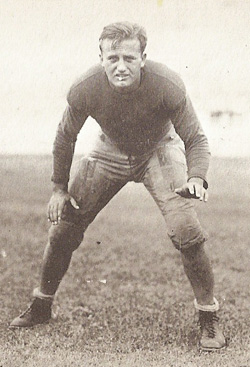
Jess Tinsley

Babe Godfrey
|
|
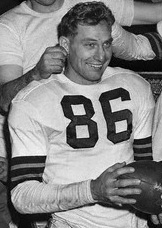
William "Dub" Jones
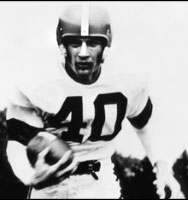
Dub Jones
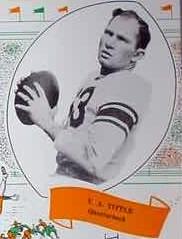
Y.A. Tittle with the Baltimore Colts of the AAFC
Top of Page |
William "Dub" Jones is the only man ever to play for LSU against Tulane and for Tulane against LSU. He is more famous today as the father of LSU All-American QB Bert Jones.
- Dub was born in Arcadia in northern LA at the very end of 1924.
- His father was killed when Dub was 3, the youngest of four boys. His mother moved the family to Ruston, 18 miles away.
- Dub enjoyed listening to baseball games and boxing matches on the radio. The first sport he played was Little League Baseball.
- All three of his brothers were athletes. They played American Legion baseball and high school football. Carroll, the brother just ahead of Dub, went to LSU on a football scholarship. Carroll lettered in 1941 before departing for World War II.
- Dub says, "I went to every football game, baseball game, and boxing match at Louisiana Tech. I lived just off campus."
At Ruston High School from 1938-41, Jones played football under "an outstanding coach," Hoss Garrett.
- "He was a young coach and had just arrived in Ruston, but, oh, he was a great coach."
- Dub was small when he entered high school and didn't make first team until his senior year, when Ruston won its first state championship.
- "We used the Notre Dame box. We would line up in a T-formation and shift one way or the other to a box. I played left halfback or tailback. We played defense and offense. Stayed in the game the whole time"
- Dub also played baseball, basketball, and boxed in high school.
- Garrett would later coach Dub's son Bert at Ruston.
Because his brother was at LSU, the Tiger coaches knew about Dub.
- "I went to LSU because I had decided that I wanted to play at as big a level as I could. Their offer was a full scholarshiop, which meant tuition and books, room and board, laundry, and fifteen dollars a month for spending money. ... That was a great, great offer, and there was no hesitation from me."
- Although there was an athletic dorm at The Old War Skule with a "great cafeteria," the freshmen stayed in the barracks with the other students.
- Dub lettered for LSU in 1942, his sophomore year. (Freshmen were ineligible until the war began for the U.S. in 1942.) He was a 6'2" 158 "spindly" back on Bernie Moore's 7-3 team.
- The Tigers beat Tulane 18-6 at Baton Rouge on Thanksgiving afternoon in the annual finale. The game is most remembered for what happened after the final gun. Hundreds of the 35,000 fans poured onto the field to trade blows in wild melees.
- One of Dub's teammates was a future NFL Hall of Famer he would meet on the gridiron more than once as a pro - RB Steve Van Buren.
World War II intervened to change the direction of Dub's life.
- "I went into the navy, and they sent me to Tulane University. I was in the V-12 program and attended classes and played football at Tulane for two years, 1943 and 1944."
- Alvin Dark, Jones' sophomore classmate at LSU and an all-SEC player in 1942, played for Southwestern Louisiana Institute in 1943 as part of the navy program at the Lafayette school.
Tulane, coached by former Greenie star "Monk" Simons, split with LSU the two years Jones played for the Green Wave.
- "Billy Jones," as he was called in newspaper articles at that time, sparked TU to a 27-0 triumph before 40,000 in New Orleans in 1943 as part of a 3-3 season.
- Early in Q3 of a scoreless game, Jones flipped a short pass to blocking back Leonard Finley who sprinted 62y to the end zone. However, the play was called back for clipping. Several plays later, Jones passed to E Ken Tarzetti to the Tiger 4, from where the Green Wave broke the ice. Jones added the 7th point from placement.
- Five minutes later, Billy slashed through T to paydirt after a blocked punt was recovered by Tarzetti on the one. Jones added the second of his three PATs on the day.
Jones and Company lost 25-6 at Tiger Stadium in '44 to finish 4-3.
- Dub, as he was now called in newspaper accounts, scored the only Green Wave touchdown of the afternoon in Q3 to culminate a 65y drive.
- "Little Jack Tittle," a freshman QB who would be known in football history as Y. A. Tittle, led the Tiger attack. Jones would compete against Y. A. many times in two different pro football leagues.
After completing his active duty in the Navy, Jones was drafted in the first round in 1946 by the Chicago Cardinals of the NFL.
- Dub asked for a $10,000 salary. "Jimmy Conzelman, the Cardinals' coach, said, 'Oh, that's unheard of! We can't pay that!' So I said, 'Well, I don't want to play pro football anyway. I want to go back and finish college.' I hadn't finished, and I still had a year of eligibility left, because the war years didn't count."
- However, the Miami Seahawks of the new All-America Football Conference offered him $12,000 a year.
- "I reallly wanted to go to the Cardinals, who had a great team. But Conzelman said, 'No, that's too much money.' So I called Miami back and said I'd sign with them. In the meantime, Conzelman checked it out and found I was telling the truth. He called me back and offered me another $2,000. I replied that I'd already told the Seahawks I'd sign with them."
After playing two seasons with the Seahawks and the Brooklyn Dodgers, Jones moved to the AAFC powerhouse, the Cleveland Browns.
- Paul Brown, the Cleveland coach and source of the team's nickname, traded his first round draft choice, Bob Chappius of Michigan, to get Dub.
- "Boy, that made me feel really worth something, for Cleveland to trade its first round draft choice for me. Paul Brown told that story many times, that the greatest trade he ever made was when he traced Chappius to Brooklyn for Dub Jones."
- Brown was interested in Dub as a DB and that's where Dub opened the season. However, Jones didn't do too well in the secondary. So Brown transferred him to offense where he starred for eight seasons.
- The Browns won the AAFC championship in both '48 and '49 before transferring to the NFL, where they took the crown in '50, lost in the finals in '51, '52, and '53, and copped the title again in '54 and '55.
- Dub made first team All-Pro in '51 and played in the Pro Bowl that year and the following one. The highlight of his 1951 season was scoring six touchdowns against the Chicago Bears, which tied the record for most touchdowns in a game.
After retiring following the '55 season, Dub was in business in Ruston for seven years.
- He returned to Cleveland as the offense coordinator for new coach Blanton Collier, a position he held for five years (1963-67).
- The highlight of his coaching career was winning the 1964 NFL championship over the Baltimore Colts.
Dub left football for good to enjoy the career of his son Bert at LSU from 1970-72 and of his younger son Ben, a Tiger SE from 1972-74.
Reference: Real Football: Conversations on America's Game, Stephen H. Norwood
|
|
|
CONTENTS
First Southern Team to Fly to a Game
Memorable Game: FSU 1991
Did You Know? 7-0 in 1973
Profile: John Ed Bradley
Super Bowl Bengals – I
Super Bowl Bengals – II
Recruiting Tales I
Memorable Game: Tulane 1937
Scoreless String
Profile: Dub Jones
Tiger Den Archives – I
Tiger Den Archives – II
Tiger Den Archives – III
Tiger Den Archives – IV
Tiger Den Archives – V
Tiger Den Archives – VII
Tiger Den Archives – VIII
Tiger Den Archives – IX
Tiger Den Archives – X
Tiger Den Archives – XI
Tiger Den Archives - XII
Football Magazine
Golden Rankings Home |

















































